考古学与史前文明 英文
马骏分类词汇
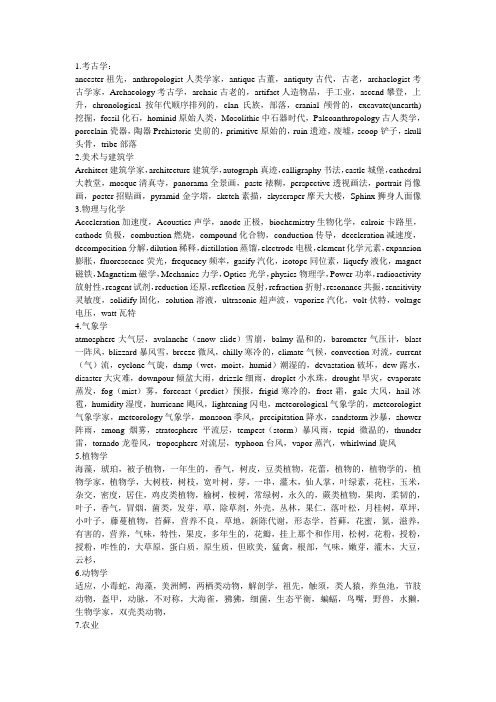
1.考古学:ancester祖先,anthropologist人类学家,antique古董,antiquty古代,古老,archaelogist考古学家,Archaeology考古学,archaic古老的,artifact人造物品,手工业,ascend攀登,上升,chronological按年代顺序排列的,clan氏族,部落,cranial颅骨的,excavate(unearth)挖掘,fossil化石,hominid原始人类,Mosolithic中石器时代,Paleoanthropology古人类学,porcelain瓷器,陶器Prehistoric史前的,primitive原始的,ruin遗迹,废墟,scoop铲子,skull 头骨,tribe部落2.美术与建筑学Architect建筑学家,architecture建筑学,autograph真迹,calligraphy书法,castle城堡,cathedral 大教堂,mosque清真寺,panorama全景画,paste裱糊,perspective透视画法,portrait肖像画,poster招贴画,pyramid金字塔,sketch素描,skyscraper摩天大楼,Sphinx狮身人面像3.物理与化学Acceleration加速度,Acoustics声学,anode正极,biochemistry生物化学,calroie卡路里,cathode负极,combustion燃烧,compound化合物,conduction传导,deceleration减速度,decomposition分解,dilution稀释,distillation蒸馏,electrode电极,element化学元素,expansion 膨胀,fluorescence荧光,frequency频率,gasify汽化,isotope同位素,liquefy液化,magnet 磁铁,Magnetism磁学,Mechanics力学,Optics光学,physics物理学,Power功率,radioactivity 放射性,reagent试剂,reduction还原,reflection反射,refraction折射,resonance共振,sensitivity 灵敏度,solidify固化,solution溶液,ultrasonic超声波,vaporize汽化,volt伏特,voltage 电压,watt瓦特4.气象学atmosphere大气层,avalanche(snow slide)雪崩,balmy温和的,barometer气压计,blast 一阵风,blizzard暴风雪,breeze微风,chilly寒冷的,climate气候,convection对流,current (气)流,cyclone气旋,damp(wet,moist,humid)潮湿的,devastation破坏,dew露水,disaster大灾难,downpour倾盆大雨,drizzle细雨,droplet小水珠,drought旱灾,evaporate 蒸发,fog(mist)雾,forecast(predict)预报,frigid寒冷的,frost霜,gale大风,hail冰雹,humidity湿度,hurricane飓风,lightening闪电,meteorological气象学的,meteorologist 气象学家,meteorology气象学,monsoon季风,precipitation降水,sandstorm沙暴,shower 阵雨,smong烟雾,stratosphere平流层,tempest(storm)暴风雨,tepid微温的,thunder 雷,tornado龙卷风,troposphere对流层,typhoon台风,vapor蒸汽,whirlwind旋风5.植物学海藻,琥珀,被子植物,一年生的,香气,树皮,豆类植物,花蕾,植物的,植物学的,植物学家,植物学,大树枝,树枝,宽叶树,芽,一串,灌木,仙人掌,叶绿素,花柱,玉米,杂交,密度,居住,鸡皮类植物,榆树,桉树,常绿树,永久的,蕨类植物,果肉,柔韧的,叶子,香气,冒烟,菌类,发芽,草,除草剂,外壳,丛林,果仁,落叶松,月桂树,草坪,小叶子,藤蔓植物,苔藓,营养不良,草地,新陈代谢,形态学,苔藓,花蜜,氮,滋养,有害的,营养,气味,特性,果皮,多年生的,花瓣,挂上那个和作用,松树,花粉,授粉,授粉,咋性的,大草原,蛋白质,原生质,但欧美,猛禽,根部,气味,嫩芽,灌木,大豆,云杉,6.动物学适应,小毒蛇,海藻,美洲鳄,两栖类动物,解剖学,祖先,触须,类人猿,养鱼池,节肢动物,盔甲,动脉,不对称,大海雀,狒狒,细菌,生态平衡,蝙蝠,鸟嘴,野兽,水獭,生物学家,双壳类动物,7.农业农业的,农业,水产业,可耕的,谷仓,温室,棉花,培养耕作,培养教养,茄子,肥沃的,饲料,大蒜,谷仓,放牧,温室,收获,甘草堆,园艺,管理,,本土的,灌溉,家畜,施肥于,果园,牧地,猪圈,种植园,家禽,多产的,大农场,苗床,淤泥,拖拉机,野草,8.微生物抗体,细菌,钙,碳水化合物,细胞,染色体,消毒,酵母,发酵,真菌,基因,葡萄糖,免疫学,传染,微生物,微生物的,细胞核,氧化,寄生虫学,病菌,青霉素,原生动物,卫生,血吸虫病,淀粉,灭菌,毒素,疫苗,病毒,酵母9.天文学小行星,天文学,天文物理学,天上的,星团,星座,宇宙的,宇宙学,宇宙,白矮星,微弱的,星系,天空天堂,点燃,图像,无限的,干扰仪,银河间的,恒星间的,木星,光度,月球的,火星,火星的,厚重的,水星,陨石,天文馆,冥王星,北极星,伪科学,类星体,辐射,公转,旋转,自转,人造卫星,土星,太阳的,太空船,旋转,恒星的,望远镜,宇宙的,宇宙,天王星,金星,10.地质学铝,富矿带,地上,火山口,钻石,翡翠,喷出爆发,断层,宝石,地质学家,地质学,地磁学,冰川的,冰川,花岗岩,冰山,铁,火山岩浆,地层,铅,石灰岩,岩石圈,小屋,经度,岩浆,地震震级,地幔,大理石,矿物矿石,镍,氮,轨道,矿石,爆发,山顶,石化,坑,板块,白金,石英,石英岩,峡谷,开垦,暗礁,遗迹,残余物,移动,脊背,断裂裂缝,河床,地震,地震图,地震仪,地震学,地震测量,验震器,银,斜坡,钠,泉水,喷出,地层学,硫磺,山顶,沼泽地,温带的,解冻,锡,颤动,支流,隧道,山谷,植被,垂直的,火山的,火山,分水岭,锌11地理学.12.文学与音乐伴奏唯美主义寓言传记民谣大提琴和旋单簧管协奏曲指挥,日记,二重唱,社论,尾声,随笔小说未来主义和声竖琴传说催眠曲人物原型现代主义情节指挥台诗歌序曲序言散文言语现实主义小夜曲独奏奏鸣曲超现实主义交响乐节拍中提琴小提琴。
历史英语词汇大全探索历史学术语重温历史的壮丽卷
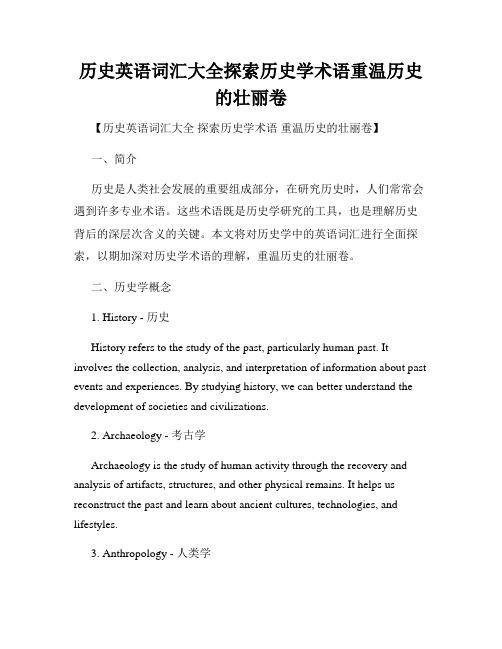
历史英语词汇大全探索历史学术语重温历史的壮丽卷【历史英语词汇大全探索历史学术语重温历史的壮丽卷】一、简介历史是人类社会发展的重要组成部分,在研究历史时,人们常常会遇到许多专业术语。
这些术语既是历史学研究的工具,也是理解历史背后的深层次含义的关键。
本文将对历史学中的英语词汇进行全面探索,以期加深对历史学术语的理解,重温历史的壮丽卷。
二、历史学概念1. History - 历史History refers to the study of the past, particularly human past. It involves the collection, analysis, and interpretation of information about past events and experiences. By studying history, we can better understand the development of societies and civilizations.2. Archaeology - 考古学Archaeology is the study of human activity through the recovery and analysis of artifacts, structures, and other physical remains. It helps us reconstruct the past and learn about ancient cultures, technologies, and lifestyles.3. Anthropology - 人类学Anthropology is the study of humans and human societies, focusing on their culture, biology, language, and social structures. It provides insights into the diversity and evolution of human beings.4. Paleontology - 古生物学Paleontology is the study of prehistoric life through the examination of plant and animal fossils. It helps us understand the history of life on Earth and the evolutionary processes that have shaped different species.5. Historiography - 历史学方法论Historiography refers to the study of historical writing and the methods used by historians to gather and interpret information. It involves analyzing sources, evaluating evidence, and constructing narratives about the past.三、历史时期1. Ancient History - 古代史Ancient history refers to the period of human history before the Middle Ages, typically covering the civilizations of Mesopotamia, Egypt, Greece, Rome, and others. It encompasses a wide range of cultures and developments.2. Medieval History - 中世纪史Medieval history covers the period between the fall of the Western Roman Empire and the beginning of the Renaissance. It includes the rise of feudalism, the spread of Christianity, and the development of chivalry and Gothic art.3. Renaissance - 文艺复兴The Renaissance was a cultural and intellectual movement in Europe that spanned from the 14th to the 17th century. It marked a shift from the medieval to the modern world, with significant advancements in art, science, and philosophy.4. Enlightenment - 启蒙运动The Enlightenment was an intellectual and philosophical movement in Europe during the 18th century. It emphasized reason, rationality, and science, challenging traditional authority and promoting individual freedom and equality.5. Industrial Revolution - 工业革命The Industrial Revolution was a major turning point in human history, characterized by the transition from handmade goods to machine production. It began in the late 18th century in Britain and had far-reaching impacts on society, economy, and technology.四、重要历史事件1. American Revolution - 美国革命The American Revolution was a political and military conflict between Great Britain and thirteen British colonies in North America. It resulted in the formation of the United States of America and inspired revolutionary movements worldwide.2. French Revolution - 法国大革命The French Revolution was a period of radical social and political upheaval in France, resulting in the overthrow of the monarchy and the riseof Napoleon Bonaparte. It had a profound impact on European history andthe spread of democratic ideals.3. World War I - 第一次世界大战World War I was a global conflict that lasted from 1914 to 1918, involving many of the world's major powers. It caused unprecedented destruction and loss of life, leading to significant political and social changes.4. Cold War - 冷战The Cold War was a period of political tension and rivalry between the United States and the Soviet Union after World War II. It was characterized by the arms race, ideological competition, and proxy wars, shaping global politics for several decades.5. Civil Rights Movement - 民权运动The Civil Rights Movement was a social and political struggle for equal rights and racial equality, primarily in the United States. It challenged racial segregation and discrimination, leading to significant legal and social changes.五、结语通过对历史学术语的探索,我们可以更深入地理解过去文明的发展和演变。
探索古代文明学习英文中与古代文明和考古发现相关的词汇
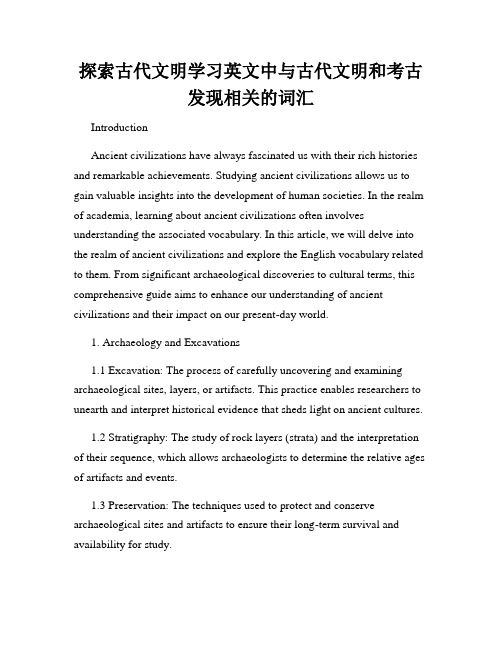
探索古代文明学习英文中与古代文明和考古发现相关的词汇IntroductionAncient civilizations have always fascinated us with their rich histories and remarkable achievements. Studying ancient civilizations allows us to gain valuable insights into the development of human societies. In the realm of academia, learning about ancient civilizations often involves understanding the associated vocabulary. In this article, we will delve into the realm of ancient civilizations and explore the English vocabulary related to them. From significant archaeological discoveries to cultural terms, this comprehensive guide aims to enhance our understanding of ancient civilizations and their impact on our present-day world.1. Archaeology and Excavations1.1 Excavation: The process of carefully uncovering and examining archaeological sites, layers, or artifacts. This practice enables researchers to unearth and interpret historical evidence that sheds light on ancient cultures.1.2 Stratigraphy: The study of rock layers (strata) and the interpretation of their sequence, which allows archaeologists to determine the relative ages of artifacts and events.1.3 Preservation: The techniques used to protect and conserve archaeological sites and artifacts to ensure their long-term survival and availability for study.1.4 Artifact: Any object created, used, or modified by humans in the past, such as tools, pottery, or artwork. Artifacts provide crucial insights into the cultural, social, and technological aspects of ancient civilizations.2. Ancient Civilizations2.1 Mesopotamia: An ancient region located in present-day Iraq, known as the "cradle of civilization." Mesopotamia gave birth to many influential civilizations, including the Sumerians, Babylonians, and Assyrians.2.2 Egyptology: The study of ancient Egyptian history, language, culture, and art. Egyptology allows us to decipher hieroglyphs, understand their complex religious beliefs, and explore the mysteries of the Pharaohs.2.3 Indus Valley Civilization: One of the world's oldest urban civilizations, remarkable for its well-planned cities and extensive trade networks. The Indus Valley Civilization flourished around 2600 to 1900 BCE in what is now Pakistan and northwestern India.2.4 Mayan Civilization: A complex and sophisticated civilization that flourished in Mesoamerica, encompassing present-day Mexico, Guatemala, Belize, Honduras, and El Salvador. The Mayans excelled in astronomy, mathematics, and craftsmanship.2.5 Ancient Greece: Renowned as the birthplace of democracy, philosophy, and classical art, Ancient Greece left an indelible mark on Western civilization. The Greeks made significant contributions to literature, architecture, and governance.3. Monuments and Architectural Marvels3.1 Pyramids: Monumental structures built by several ancient civilizations, including the Egyptians and Mayans, primarily as burial sites for their rulers.3.2 Colosseum: A colossal amphitheater located in Rome, Italy, constructed by the ancient Romans. It hosted various public spectacles, including gladiatorial contests and theatrical performances.3.3 Parthenon: A magnificent temple dedicated to the Greek goddess Athena, located in Athens, Greece. The Parthenon is an iconic symbol of ancient Greek architecture and is recognized as a UNESCO World Heritage Site.3.4 Great Wall of China: A breathtaking feat of engineering, the Great Wall stretches over 13,000 miles across northern China. Built to protect against invasions, it represents an enduring symbol of Chinese civilization.4. Cultural Concepts and Beliefs4.1 Polytheism: The belief in and worship of multiple gods and goddesses. This religious practice was prevalent in ancient civilizations, such as Mesopotamia, Greece, and Rome.4.2 Mythology: The collection of myths, legends, and stories that explain the beliefs and practices of ancient cultures. Greek and Norse mythology are among the most well-known examples.4.3 Oracle: A person or place regarded as a source of divine guidance or prophetic predictions. Ancient civilizations consulted oracles to seek advice on matters of significance, often through complex rituals.4.4 Pharaoh: The title given to the rulers of ancient Egypt. Pharaohs were considered divine figures and held immense political and religious power.4.5 Hieroglyphs: The ancient Egyptian writing system, consisting of pictorial symbols. Deciphering hieroglyphs has provided valuable insights into the lives and histories of the ancient Egyptians.ConclusionExploring ancient civilizations and their enduring legacies deepens our understanding of humanity's collective past. By familiarizing ourselves with the English vocabulary related to these civilizations, we can engage in meaningful discussions and appreciate the cultural, artistic, and technological achievements of our ancestors. From the pyramids of Egypt to the myths of Greece, the study of ancient civilizations transcends borders and unites us in our shared human heritage.。
英语阅读补充资料考古学Archaeology
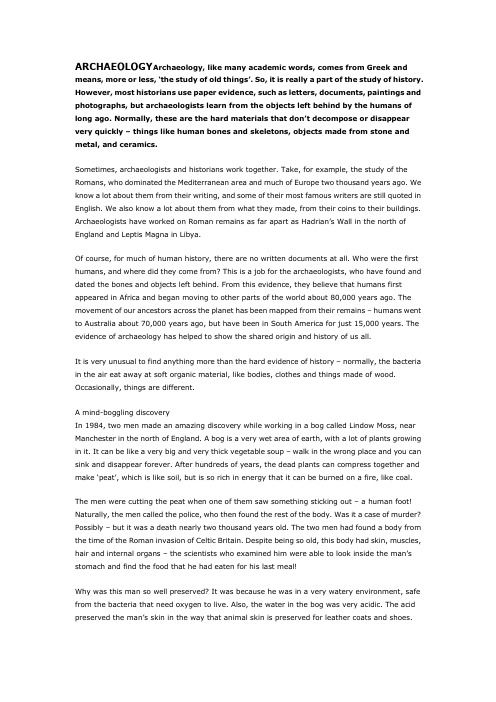
ARCHAEOLOGY Archaeology, like many academic words, comes from Greek and means, more or less, ‘the study of old things’. So, it is really a part of the study of history. However, most historians use paper evidence, such as letters, documents, paintings and photographs, but archaeologists learn from the objects left behind by the humans of long ago. Normally, these are the hard materials that don’t decompose or disappear very quickly – things like human bones and skeletons, objects made from stone and metal, and ceramics.Sometimes, archaeologists and historians work together. Take, for example, the study of the Romans, who dominated the Mediterranean area and much of Europe two thousand years ago. We know a lot about them from their writing, and some of their most famous writers are still quoted in English. We also know a lot about them from what they made, from their coins to their buildings. Archaeologists have worked on Roman r emains as far apart as Hadrian’s Wall in the north of England and Leptis Magna in Libya.Of course, for much of human history, there are no written documents at all. Who were the first humans, and where did they come from? This is a job for the archaeologists, who have found and dated the bones and objects left behind. From this evidence, they believe that humans first appeared in Africa and began moving to other parts of the world about 80,000 years ago. The movement of our ancestors across the planet has been mapped from their remains – humans went to Australia about 70,000 years ago, but have been in South America for just 15,000 years. The evidence of archaeology has helped to show the shared origin and history of us all.It is very unusual to find anything more than the hard evidence of history – normally, the bacteria in the air eat away at soft organic material, like bodies, clothes and things made of wood. Occasionally, things are different.A mind-boggling discoveryIn 1984, two men made an amazing discovery while working in a bog called Lindow Moss, near Manchester in the north of England. A bog is a very wet area of earth, with a lot of plants growing in it. It can be like a very big and very thick vegetable soup – walk in the wrong place and you can sink and disappear forever. After hundreds of years, the dead plants can compress together and make ‘peat’, which is like soil, but is so rich in energy that it can be burned on a fire, like coal.The men were cutting the peat when one of them saw something sticking out – a human foot! Naturally, the men called the police, who then found the rest of the body. Was it a case of murder? Possibly – but it was a death nearly two thousand years old. The two men had found a body from the time of the Roman invasion of Celtic Britain. Despite being so old, this body had skin, muscles, hair and internal organs –the scientists who examined him were able to look inside the man’s stomach and find the food that he had eaten for his last meal!Why was this man so well preserved? It was because he was in a very watery environment, safe from the bacteria that need oxygen to live. Also, the water in the bog was very acidic. The acid preserved the man’s skin in the way that animal skin is preserved for leather coats and shoe s.How did he die?Understandably, archaeologists and other scientists wanted to know more about the person that they called, ‘Lindow Man’. His hands and fingernails suggested that he hadn’t done heavy manual work in his life– he could have been a rich ma n or a priest. They found that he hadn’t died by accident. The forensic examination revealed that he had been hit on the head three times and his throat was cut with a knife. Then a rope was tightened around his neck. As if that wasn’t enough, he was then thrown into the bog.So, Lindow Man was killed using three different methods, when just one would have been sufficient. The archaeologists believe that he was sacrificed to three different Celtic gods, called Taranis, Esus and Teutates. Each god required a different form of death. A sacrifice to Teutates required drowning, which is why he was found in the bog. Nobody can tell the complete story of Lindow Man. The Romans said that the Celts made sacrifices every May to make sure that there was enough food t hat year. Was he a typical ‘routine’ sacrifice?An archaeologist called Anne Ross has suggested that Lindow Man was a special case. Why would an important man be sacrificed to three gods? Perhaps it was in response to the Roman invasion of Britain, which started in the year AD 43, close to the time that Lindow Man died. He might have been killed to gain the help of the gods against the Romans. It didn’t work. The Romans stayed in Britain for four hundred years and Lindow Man stayed in his bog for two thousand.Say hello to Lindow ManIf you visit London, you can go and see Lindow Man at the British Museum, where he is spending some time in the company of more famous mummies from Egypt. Whereas the bodies of the Egyptian kings and queens were intentionally preserved, Lindow Man is with us by accident. Whatever his origins, it is a fascinating experience to see him face to face. I recommend it.。
考古学的意义英文作文100词
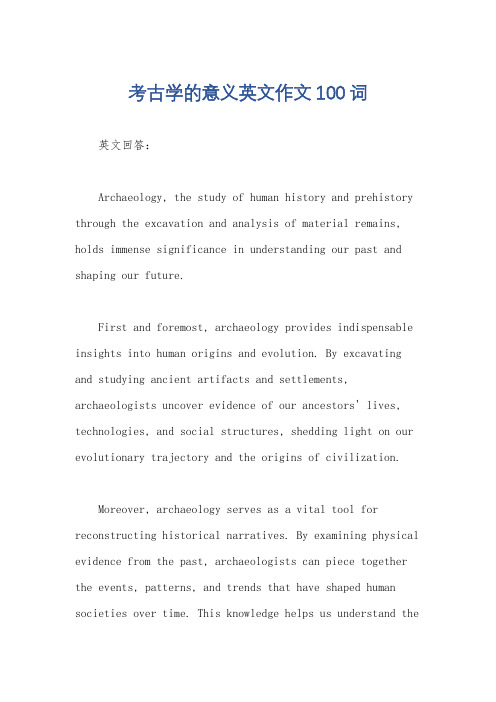
考古学的意义英文作文100词英文回答:Archaeology, the study of human history and prehistory through the excavation and analysis of material remains, holds immense significance in understanding our past and shaping our future.First and foremost, archaeology provides indispensable insights into human origins and evolution. By excavating and studying ancient artifacts and settlements, archaeologists uncover evidence of our ancestors' lives, technologies, and social structures, shedding light on our evolutionary trajectory and the origins of civilization.Moreover, archaeology serves as a vital tool for reconstructing historical narratives. By examining physical evidence from the past, archaeologists can piece together the events, patterns, and trends that have shaped human societies over time. This knowledge helps us understand therise and fall of civilizations, the development of cultural and technological advancements, and the interconnections between different societies.Archaeology also plays a crucial role in cultural preservation and heritage management. It helps us identify, protect, and conserve archaeological sites and artifacts that hold cultural and historical value. Archaeological research contributes to preserving our shared human heritage, allowing us to connect with our past and appreciate the diversity of human cultures.Additionally, archaeology has practical applications in fields such as environmental studies and urban planning. By examining ancient landscapes and settlements, archaeologists can gain insights into past environmental conditions, climate change, and resource management practices. This knowledge aids in developing sustainable practices for the present and future.Furthermore, archaeology fosters interdisciplinary collaboration and innovation. It brings together scholarsfrom various fields, including history, anthropology, geology, and biology, to work collectively on reconstructing the human past. This collaboration leads to the development of new methodologies, theoretical approaches, and research questions that advance our understanding of human history.中文回答:考古学,通过挖掘和分析物质遗存来研究人类历史和史前史,对于理解我们的过去和塑造我们的未来具有重要意义。
中国考古英语作文

中国考古英语作文Chinese Archaeology。
Chinese archaeology is a fascinating and importantfield of study that has contributed greatly to our understanding of ancient Chinese history and culture. Through the excavation of ancient sites and the analysis of artifacts, archaeologists have been able to piece together a comprehensive picture of the development of Chinese civilization over thousands of years.The history of Chinese archaeology can be traced back to the early 20th century, when the first systematic excavations were carried out at sites such as Anyang, the ancient capital of the Shang dynasty. These early excavations revealed the existence of a sophisticated and advanced civilization that had developed in China more than 3,000 years ago. Since then, Chinese archaeologists have made numerous groundbreaking discoveries that have shed light on the lives of ancient Chinese people and thesocieties they lived in.One of the most important archaeological discoveries in China is the tomb of the First Emperor of the Qin dynasty, Qin Shi Huang. Discovered in 1974, the tomb contained a vast underground palace filled with a life-sized army of terracotta warriors and horses, as well as numerous other treasures. This discovery provided valuable insights into the funerary practices and beliefs of the ancient Chinese, as well as the military technology of the time.In recent years, Chinese archaeologists have also made significant discoveries in the field of underwater archaeology. Excavations of ancient shipwrecks and submerged cities have revealed the extent of maritime trade and cultural exchange in ancient China, as well as the advanced technology and craftsmanship of ancient Chinese shipbuilders.In addition to excavations, Chinese archaeologists also use a variety of scientific techniques to analyze and interpret the artifacts they uncover. For example, carbondating and DNA analysis can provide valuable information about the age and origins of ancient artifacts, while advanced imaging techniques can reveal hidden details and inscriptions on ancient objects.Chinese archaeology not only contributes to our understanding of ancient Chinese history and culture, but also has important implications for the present and future. By studying the successes and failures of past civilizations, archaeologists can gain valuable insights into the challenges facing modern society and the potential consequences of our actions. In addition, the preservation and protection of ancient sites and artifacts is crucialfor maintaining a connection to our cultural heritage and ensuring that future generations can learn from the past.In conclusion, Chinese archaeology is a vital and dynamic field of study that continues to make important contributions to our understanding of ancient Chinese history and culture. Through the excavation of ancient sites, the analysis of artifacts, and the application of scientific techniques, Chinese archaeologists are able touncover the secrets of the past and preserve our cultural heritage for future generations.。
考古学相关的英语单词
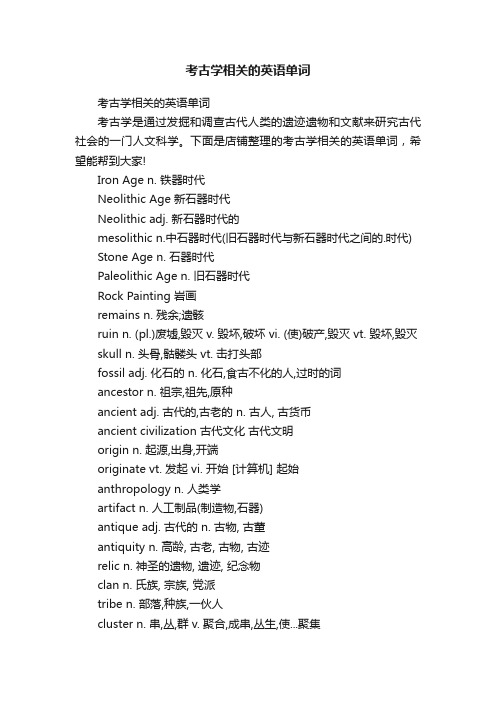
考古学相关的英语单词考古学相关的英语单词考古学是通过发掘和调查古代人类的遗迹遗物和文献来研究古代社会的一门人文科学。
下面是店铺整理的考古学相关的英语单词,希望能帮到大家!Iron Age n. 铁器时代Neolithic Age 新石器时代Neolithic adj. 新石器时代的mesolithic n.中石器时代(旧石器时代与新石器时代之间的.时代) Stone Age n. 石器时代Paleolithic Age n. 旧石器时代Rock Painting 岩画remains n. 残余;遗骸ruin n. (pl.)废墟,毁灭 v. 毁坏,破坏 vi. (使)破产,毁灭 vt. 毁坏,毁灭skull n. 头骨,骷髅头 vt. 击打头部fossil adj. 化石的 n. 化石,食古不化的人,过时的词ancestor n. 祖宗,祖先,原种ancient adj. 古代的,古老的 n. 古人, 古货币ancient civilization 古代文化古代文明origin n. 起源,出身,开端originate vt. 发起 vi. 开始 [计算机] 起始anthropology n. 人类学artifact n. 人工制品(制造物,石器)antique adj. 古代的 n. 古物, 古董antiquity n. 高龄, 古老, 古物, 古迹relic n. 神圣的遗物, 遗迹, 纪念物clan n. 氏族, 宗族, 党派tribe n. 部落,种族,一伙人cluster n. 串,丛,群 v. 聚合,成串,丛生,使...聚集dinosaur n. 恐龙 n.(俚)过时、落伍的人或事物paleontology n. 古生物学prehistoric adj. 史前的excavate v. 挖掘, 挖开, 凿通unearth vt. 发掘, 掘出,发现并披露hominid n. 原始人类 adj. 灵长类的Bronze Age n. 青铜器时代。
历史学专业英语词汇

Unit 1history ['histri] n. 历史,历史学narrative ['nærətiv] n. 记事,叙事Herodotus [hə'rɔdətəs] n. 希罗多德circa ['sə:kə] prep. (拉丁语)大约(简写c., ca., cir., circ., C.)Thucydides [θju'sidədi:z] n. 修昔底德chronological [.krɔnə'lɔdʒikəl] adj. 年代学的,按年代顺序的territorial [.teri'tɔ:riəl] adj. 区域性的,地方性的thematically [θi'mætikli] adv. 按主题方式,按专题方式Big History 大历史(学派)archaeology [.ɑ:ki'ɔlədʒi] n. 考古学methodology [.meθə'dɔlədʒi] n. 方法论approach [ə'prəutʃ] n. 研究方法discipline ['disiplin] n. 学科perspective [pə'spektiv] n. 观点the humanities [hju:'mænitiz] 人文学科the social sciences 社会科学classification [.klæsifi'keiʃən] n. 分类anthropology [.ænθrə'pɔlədʒi] n. 人类学global history 全球史historiography [.histɔ:ri'ɔgrəfi] n. 历史编纂学,史学史,文献学biographical [.baiə'græfikəl] adj. 传记的,传记体的thematic [θi'mætik] adj. 主题的,专题的medieval [medi'i:vəl] adj. 中世纪的philosophy of history 历史哲学meta-level ['metə 'levəl]总体层面,元级teleological [.teli'ɔlədʒikəl] adj. 目的论的diplomatic [.diplə'mætik] adj. 外交的historical method 史学方法primary sources 原始材料epistemology [i.pisti'mɔlədʒi] n. 认识论Peloponnesian [.peləpə'ni:ʃən] adj. 伯罗奔尼撒半岛的divine [di'vain] adj. 神的,神圣的chronology [krə'nɔlədʒi] n. 编年史cyclical ['saiklikl] adj. 循环的posthumous ['pɔstjuməs] adj. 身后的,死后的dynastic [dai'næstik] adj. 王朝的Saint Augustine [seint ɔ:'gʌstin] n. 圣奥古斯丁Christian ['kristjən] adj. 基督教的,基督教徒的the Renaissance [rə'neisəns] n. 文艺复兴,文艺复兴时期religious [ri'lidʒəs] adj. 宗教的Hegel ['heigl] n. 黑格尔secular ['sekjulə] adj. 世俗的Ranke [ræŋk] n. 兰克epic ['epik] adj. 史诗的,叙事的;史诗,叙事诗nationalistic [.næʃənəl'istik] adj. 民族主义的Fernand Braudel [fer'nan brɔ'del] 费尔南•布罗代尔Le Roy Ladurie [lə rwa ladju'ri:] 拉鲁瓦•拉杜里Marc Bloch [mark blɔk] 马克•布洛克Lucien Febvre [lysjæn fevr] 吕西安•费弗尔multi-disciplinary [.mʌlti'disiplinəri] adj. 多学科的the Annales ['ænəlz] School 年鉴学派quantitative history 数量史学raw data 原始数据ethnic ['eθnik] adj. 族群的,族裔的racial ['reiʃəl] adj. 种族的genre ['ʒɑ:nrə] n. 类型,流派,风格history of everyday life 日常生活史Marxist ['mɑ:ksist] adj., n. 马克思主义(者)的;马克思主义者Eric Hobsbawm ['erik 'hɔbsbɔm] 埃里克•霍布斯鲍姆Georges Lefebvre [ʒɔrʒ lə'fevr] 乔治•勒费弗尔François Furet [fran'swa fy're] 弗朗索瓦•弗雷Roland Mousnier [rɔ'lan mu:'njei] 罗兰•穆尼埃anti-Marxist adj. 反马克思主义的feminist ['feminist] adj. 女性主义的,女权主义的;女权主义者postmodernist [.pəust'mɔdərnist] n., adj. 后现代主义者;后现代主义(者)的Richard Evans ['ritʃəd 'evənz] 理查德•埃文斯Keith Windschuttle [keiθ 'winʃʌtl] 凯斯•温修德historical periodization [piəriədai'zeiʃən] 历史分期classificatory [.klæsifi'keitəri] adj. 类别的,分类上的retrospective [.retrəu'spektiv] adj. 事后回想的,回顾的the Gilded Age 镀金时代the Dark Age(s) 黑暗时代the First World War 第一次世界大战decimal ['desiməl] adj. 十进法的,以十为基础的talismanic [.tæliz'mænik] adj. 护符(般)的,有护符般效力的the Victorian [vik'tɔ:riən] Era 维多利亚时代the Napoleonic [nə.pəuli'ɔnik] Era 拿破仑时代the Meiji ['mei'dʒi:] Era 明治时代the Merovingian [.mærə'vindʒiən] Period 墨洛温王朝时期Romantic [rə'mæntik] period 浪漫主义时期the sexual ['seksjuəl] revolution 性革命conservative [kən'sə:vətiv] adj. 保守的Roman Catholic ['kæθəlik] culture 罗马天主教文化Franco ['frɔŋkəu] n. 弗朗哥Unit 2primitive culture 原始文化Paul Tournal [pɔl turnal] 保罗·杜纳尔anté-historique ['a:ŋtei 'istɔrik] n.(法语)史前的prehistoric ['pri:his'tɔrik] n. 史前的Daniel Wilson ['dænjəl 'wilsn] 丹尼尔·威尔逊prehistorian [pri:hi'stɔ:riən] n. 从事史前史研究的专家,史前史学家the Stone Age 石器时代the Bronze Age 青铜器时代the Iron Age 铁器时代excavation [.ekskə'veiʃən] n. 发掘geologic [dʒiə'lɔdʒik] adj. 地质学的geographic [dʒiə'græfik] adj. 地理学的literate ['litərit] adj. 识字的,有文化的geneticist [dʒi'netisist] n. 遗传学家linguist ['liŋgwist] n. 语言学家paleontology [.pæliɔn'tɔlədʒi] n. 古生物学biology [bai'ɔlədʒi] n. 生物学geology [dʒi'ɔlədʒi] n. 地质学archaeoastronomy [.ɑ:kiəuəs'trɔnəmi] n. 考古天文学linguistics [liŋ'gwistiks] n. 语言学molecular [mə'lekjulə] adj. 分子的genetics [dʒi'netiks] n. 遗传学archaeological [.a:kiə'lɔdʒikəl] adj. 考古的,考古学上的artifact ['ɑ:tifækt] n. 人工制品anonymous [ə'nɔniməs] adj. 无名无姓的,匿名的Neanderthal [ni'ændətɑ:l] n. 尼安德特人academic [.ækə'demik] adj. 学术上的,从事学术研究的New Guinea [nju: 'gini] n. 新几内亚Paleolithic [.pæliəu'liθik] n. 旧石器时代;adj. 旧石器时代的the Lower Paleolithic 旧石器时代早期Homo sapiens ['həuməu 'seipienz] n. 智人(现代人的学名)Homo habilis ['həuməu 'hæbilis] n. 能人species ['spi:ʃi:z] n. 种类,物种usher ['ʌʃə] vi. 引入,引导anatomic [.ænə'tɔmik] adj. 解剖学上的burial ['beriəl] n. 埋葬,葬礼,坟墓sophisticated [sə'fisti.keitid] adj. 复杂的,精密的,老练的highlight ['hailait] n. 精彩部分,闪光点the Middle Paleolithic 旧石器时代中期the Cro-Magnon ['krəʊ'mænjɔŋ] n. 克罗马尼翁人nomadic [nəu'mædik] adj. 游牧的,游牧民族的,流浪的hunter-gatherer n. 捕猎采集者egalitarian [i.gæli'tɛəriən] adj. 平等主义的sedentary ['sedən.təri] adj. 定居的,固定不动的chiefdom ['tʃi:fdəm] n. 首领的地位,首领的权威stratification [.strætifi'keiʃən] n. 分层indigenous [in'didʒinəs] adj. 土著的,土生土长的,本地的the Upper Paleolithic 旧石器时代晚期Mesolithic [.mesə'liθik] n. 中石器时代;adj. 中石器时代的the Middle Stone Age 中石器时代Neolithic [.ni:əu'liθik] n. 新石器时代;adj. 新石器时代的Pleistocene ['plaistəusi:n] n. 更新世;adj. 更新世的millennia [mi'leniə] (millenniums) n. 数千年marshland ['mɑ:ʃlænd] n. 沼泽地midden ['midn] n. 贝冢deforestation [.di:fɔris'teiʃən] n. 森林开发,滥发森林composite ['kɔmpəzit] adj. 合成的,复合的flint [flint] n. 极硬的东西,打火石microlith ['maikrəliθ] n. 细石器microburin [.maikrə'bjuərin] n. 小雕刻刀tackle ['tækəl] n. 用具,滑车adze, adz [ædz] n. 锛子canoe [kə'nu:] n. 独木舟bow [bəu] n. 弓the New Stone Age 新石器时代domestication [də.mesti'keiʃən] n. 驯养,驯化warfare ['wɔ:fɛə] n. 战争,战事Stonehenge ['stəun'hendʒ] n. 巨石阵millennium [mi'leniəm] n. 一千年Sumerians [su:'miriəns] n. 苏美尔人Peru [pə'ru:] n. 秘鲁Mesoamerica [.mezəuə'merikə] n. 中美洲the Fertile Crescent ['kresənt] n. 新月沃地(西亚伊拉克两河流域连接叙利亚一带地中海东岸的一片弧形地区,为上古文明发源地之一)irrigation [.iri'geiʃən] n. 灌溉the Metal Age 金属时代Chalcolithic [.kælkə'liθik] n. 铜石并用时代;adj. 铜石并用时代的the Old World 旧大陆,东半球(尤指欧洲)metallurgy [me'tælədʒi] n. 冶金术,冶金学metalworking ['metəl.wə:kiŋ] n. 金属加工tin [tin] n. 锡outcropping ['autkrɔpiŋ] n. 露出,露出地表arsenic ['ɑ:sənik] n. 砷,砒霜ferrous ['ferəs] adj. 含铁的cradle ['kreidəl] n. 摇篮,发源地valley ['væli] n. 流域Euphrates [ju:'freiti:z] n. 幼发拉底河Tigris ['taigris] n. 底格里斯河Mesopotamia [.mesəpə'teimiə] n. 两河流域Nile [nail] n. 尼罗河Indus ['indəs] n. 印度河subcontinent [sʌb'kɔntinənt] n. 次大陆adjacent [ə'dʒeisənt] adj. 临近的implement ['implimənt] n. 工具,器具ornament ['ɔ:nəmənt] n. 装饰物,装饰。
考古学的意义英语作文
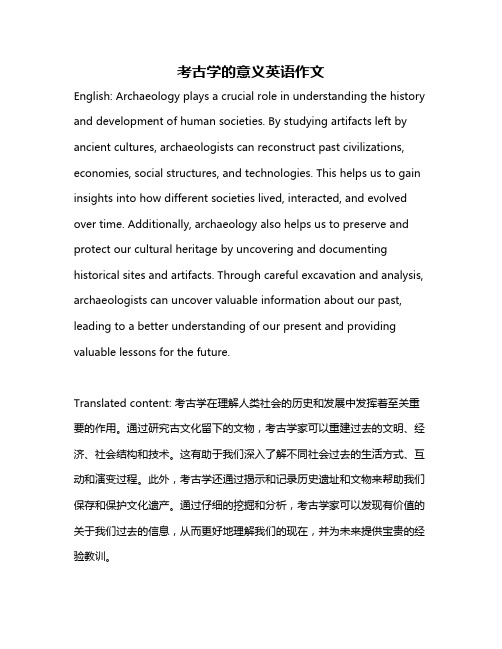
考古学的意义英语作文English: Archaeology plays a crucial role in understanding the history and development of human societies. By studying artifacts left by ancient cultures, archaeologists can reconstruct past civilizations, economies, social structures, and technologies. This helps us to gain insights into how different societies lived, interacted, and evolved over time. Additionally, archaeology also helps us to preserve and protect our cultural heritage by uncovering and documenting historical sites and artifacts. Through careful excavation and analysis, archaeologists can uncover valuable information about our past, leading to a better understanding of our present and providing valuable lessons for the future.Translated content: 考古学在理解人类社会的历史和发展中发挥着至关重要的作用。
通过研究古文化留下的文物,考古学家可以重建过去的文明、经济、社会结构和技术。
这有助于我们深入了解不同社会过去的生活方式、互动和演变过程。
有关考古的英语作文

有关考古的英语作文英文回答:Archaeology is the study of past peoples and cultures through the excavation and examination of their physical remains. Archaeologists use a variety of techniques to gather data about past societies, including excavation, survey, and analysis of artifacts and features.Archaeology is a multi-disciplinary field that draws on a variety of disciplines, including anthropology, history, geology, and biology. Archaeological research can provide insights into a wide range of topics, including human evolution, the development of agriculture, the rise andfall of civilizations, and the history of art and technology.Archaeology is also a valuable tool for cultural resource management. Archaeological surveys can help to identify and protect important cultural resources, such ashistoric sites and artifacts. Archaeology can also be usedto mitigate the impact of development on cultural resources.中文回答:考古学是通过发掘和研究人类过去遗留下来的物质遗存,来了解过去的人类和文化的学科。
关于举例考古学的意义的英语作文
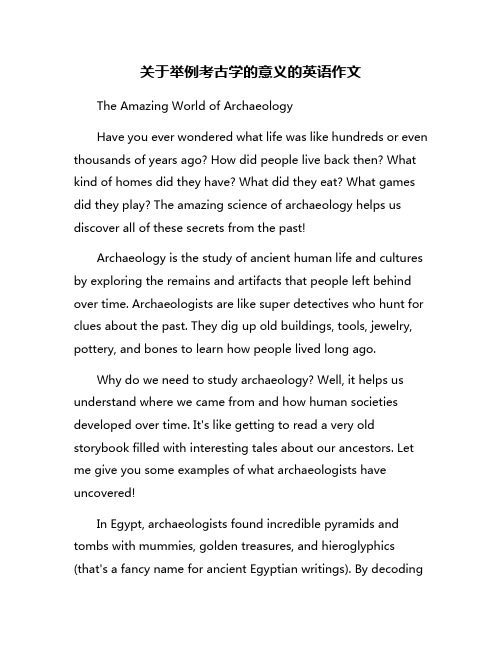
关于举例考古学的意义的英语作文The Amazing World of ArchaeologyHave you ever wondered what life was like hundreds or even thousands of years ago? How did people live back then? What kind of homes did they have? What did they eat? What games did they play? The amazing science of archaeology helps us discover all of these secrets from the past!Archaeology is the study of ancient human life and cultures by exploring the remains and artifacts that people left behind over time. Archaeologists are like super detectives who hunt for clues about the past. They dig up old buildings, tools, jewelry, pottery, and bones to learn how people lived long ago.Why do we need to study archaeology? Well, it helps us understand where we came from and how human societies developed over time. It's like getting to read a very old storybook filled with interesting tales about our ancestors. Let me give you some examples of what archaeologists have uncovered!In Egypt, archaeologists found incredible pyramids and tombs with mummies, golden treasures, and hieroglyphics (that's a fancy name for ancient Egyptian writings). By decodingthe hieroglyphs, they learned that the pyramids were giant tombs built for powerful pharaohs. Can you imagine how long it took to build something so massive with just simple tools?Over in Central America, archaeologists explored the ruins of great Mayan cities like Chichen Itza. They found tall step pyramids, ballcourts for an ancient game, and fascinating calendars carved in stone. The Maya were super smart and had their own system of writing and mathematics! Archaeologists are still working hard to unravel the many mysteries of Mayan culture.In China, archaeologists dug up pieces of the incredible Terracotta Army – thousands of life-sized clay soldier statues buried underground for over 2,000 years! Each soldier's face was unique, almost like they were real people frozen in time. Experts believe they were created to guard the tomb of an emperor in the afterlife. Wouldn't you love to see an entire army of clay warriors?Even in your own hometown, there could be archaeological sites waiting to be discovered! Maybe there are Native American artifacts like arrowheads or pottery pieces buried underground from ancient tribes that lived in your area. Or perhaps there are ruins of old buildings, roads, or bridges from pioneer days. Anarchaeologist's job is to carefully excavate (that means "dig up") these sites and study the objects they find.But archaeology isn't just about digging in the dirt. After finding ancient relics, archaeologists have to analyze and date the artifacts to figure out how old they are. They use amazing techniques like radiocarbon dating to determine an object's age. Then they get to reconstruct and put together the puzzle pieces to recreate what life was like way back when.Some of the coolest archaeological finds are fossilized human ancestors from millions of years ago! By studying ancient bones and skulls, experts can learn how humans evolved over time. There are still so many unanswered questions about our earliest ancestors that archaeologists are working hard to uncover.As you can see, archaeology is an awesome way to travel back in time and connect with our roots. Every discovery is like opening up a fresh chapter in the big book of human history. Who knows what other incredible mysteries are waiting to be uncovered?Archaeologists definitely have one of the most exciting jobs out there. If you dream of going on real-life treasure hunts and uncovering the secrets of lost civilizations, then archaeologymight be the perfect career for you someday! Just grab a trowel and brush and start digging into the past. Who knows what amazing artifacts you'll find?。
考古学英文
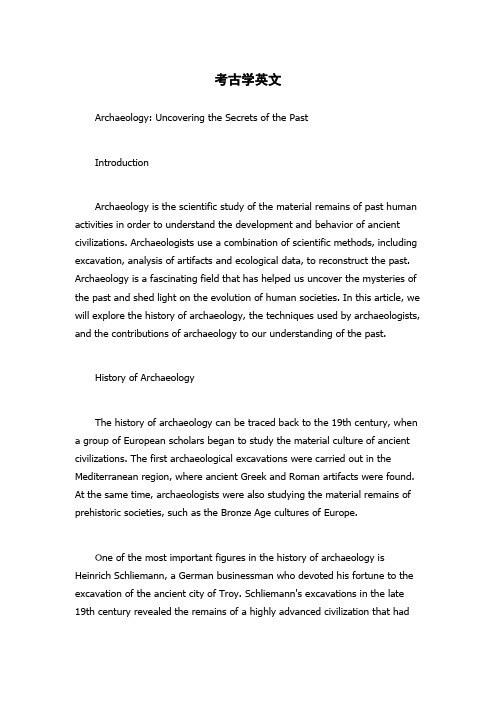
考古学英文Archaeology: Uncovering the Secrets of the PastIntroductionArchaeology is the scientific study of the material remains of past human activities in order to understand the development and behavior of ancient civilizations. Archaeologists use a combination of scientific methods, including excavation, analysis of artifacts and ecological data, to reconstruct the past. Archaeology is a fascinating field that has helped us uncover the mysteries of the past and shed light on the evolution of human societies. In this article, we will explore the history of archaeology, the techniques used by archaeologists, and the contributions of archaeology to our understanding of the past.History of ArchaeologyThe history of archaeology can be traced back to the 19th century, when a group of European scholars began to study the material culture of ancient civilizations. The first archaeological excavations were carried out in the Mediterranean region, where ancient Greek and Roman artifacts were found. At the same time, archaeologists were also studying the material remains of prehistoric societies, such as the Bronze Age cultures of Europe.One of the most important figures in the history of archaeology is Heinrich Schliemann, a German businessman who devoted his fortune to the excavation of the ancient city of Troy. Schliemann's excavations in the late 19th century revealed the remains of a highly advanced civilization that hadbeen previously unknown. Schliemann's work helped to popularize archaeology as a field of study.The early 20th century saw a new wave of archaeological discoveries, including the discovery of King Tutankhamun's tomb in Egypt by Howard Carter. The excavation of Pompeii and Herculaneum in Italy also provided a wealth of information about daily life in ancient Rome before the eruption of Mount Vesuvius.Archaeology today continues to be a vital field of study, with new discoveries being made every year. The techniques used in archaeology have become more sophisticated over time, allowing archaeologists to uncover more information about the past.Techniques of ArchaeologyArchaeologists use a variety of techniques to study the material remains of past human activities. The most basic technique is excavation, which involves digging up artifacts and other evidence of human activity from the ground. Excavation requires careful planning and execution, as the artifacts must be removed from the ground without damaging them.Other techniques used by archaeologists include mapping, surveying, and remote sensing. Mapping involves creating detailed maps of archaeological sites, while surveying involves collecting data about the location and distribution of artifacts. Remote sensing involves the use of different technologies, such as aerial photography, satellite imagery, and ground-penetrating radar, to detect buried structures and artifacts.One of the most important techniques used by archaeologists is artifact analysis. This involves examining artifacts in detail to learn about the techniques and materials used to make them. By studying artifacts, archaeologists can also gain insights into the social and economic systems of ancient societies.Contributions of ArchaeologyArchaeology has contributed greatly to our understanding of the past. By providing a glimpse into the daily lives of ancient peoples, archaeology has helped us to understand how societies developed and evolved over time. Archaeology has also helped to uncover the origins of human civilization, as well as shedding light on important events in history.One of the most important contributions of archaeology has been the study of prehistoric societies. By studying the artifacts left behind by prehistoric peoples, archaeologists have been able to reconstruct their lifestyles and behaviors. For example, the discovery of stone tools has led to a better understanding of how early humans developed technology and adapted to their environments.Archaeology has also helped to shed light on important historical events, such as the collapse of ancient civilizations. The excavation of Pompeii and Herculaneum, for example, has provided insight into the daily lives of ancient Romans before the eruption of Mount Vesuvius.ConclusionIn conclusion, archaeology is a vital field of study that has helped us to uncover the secrets of the past. Through careful analysis of material remains, archaeologists have been able to learn about the evolution of human societies and the daily lives of our ancestors. As we continue to explore the material remains of past civilizations, we will undoubtedly gain new insights into the history of humanity.。
历史考古英语作文模板
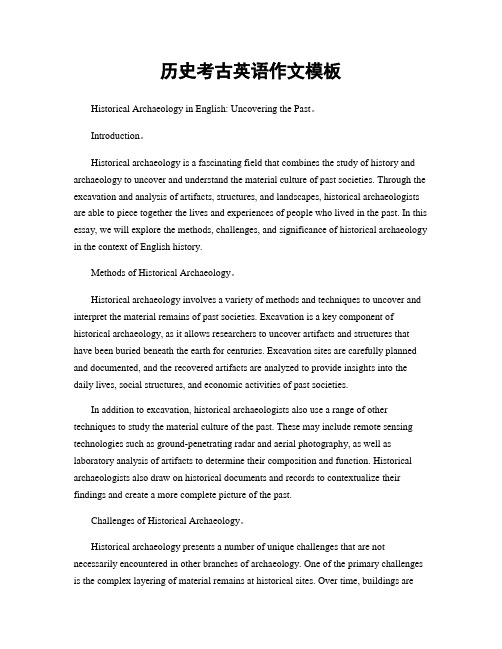
历史考古英语作文模板Historical Archaeology in English: Uncovering the Past。
Introduction。
Historical archaeology is a fascinating field that combines the study of history and archaeology to uncover and understand the material culture of past societies. Through the excavation and analysis of artifacts, structures, and landscapes, historical archaeologists are able to piece together the lives and experiences of people who lived in the past. In this essay, we will explore the methods, challenges, and significance of historical archaeology in the context of English history.Methods of Historical Archaeology。
Historical archaeology involves a variety of methods and techniques to uncover and interpret the material remains of past societies. Excavation is a key component of historical archaeology, as it allows researchers to uncover artifacts and structures that have been buried beneath the earth for centuries. Excavation sites are carefully planned and documented, and the recovered artifacts are analyzed to provide insights into the daily lives, social structures, and economic activities of past societies.In addition to excavation, historical archaeologists also use a range of other techniques to study the material culture of the past. These may include remote sensing technologies such as ground-penetrating radar and aerial photography, as well as laboratory analysis of artifacts to determine their composition and function. Historical archaeologists also draw on historical documents and records to contextualize their findings and create a more complete picture of the past.Challenges of Historical Archaeology。
- 1、下载文档前请自行甄别文档内容的完整性,平台不提供额外的编辑、内容补充、找答案等附加服务。
- 2、"仅部分预览"的文档,不可在线预览部分如存在完整性等问题,可反馈申请退款(可完整预览的文档不适用该条件!)。
- 3、如文档侵犯您的权益,请联系客服反馈,我们会尽快为您处理(人工客服工作时间:9:00-18:30)。
Archaeology Lesson Plan
This activity can be done in your own classroom using the ideas from this PowerPoint and using the Prehistoric Kentucky traveling trunk. The workshop will consist of a small series of activities and projects to fill a three hour block. There is a list of books provided (slides 14-18) relating to the topic that students can use for further independent study. Suggested follow up assignments and grading rubrics will also be supplied to the teacher.
Archaeology Lesson Plan
―The study of prehistory can contribute vitally to the students’ understanding of themselves, their society, and their culture. From the evidence archaeologists uncover, we can deduce a great deal about the ways of life in prehistoric Kentucky and make inferences about the values held by prehistoric man and the beliefs and attitudes that governed his responses. Students will discover that prehistoric people were neither savage nor ignorant, but even like themselves, sharing the same fears and dreams, encountering and solving (or not solving) similar problems. Students learn to regard their own culture and their own lives not as the culmination of human effort but as part of a continuum‖ (Carpenter & Fraser 14).
Archaeology Activity
The More Things Change, the More They Stay the Same
(artifacts found in Prehistoric Kentucky traveling trunk)
Assignment: ―After comparing artifacts from Kentucky’s prehistoric past with artifacts serving the same function from the present, students will respond to questions designed to probe their feeling about prehistory and prehistoric man in the form of an essay to be graded by their teacher. Objective: Participation in this activity will help students clarify their attitudes toward human behavior and human values‖ (Carpenter & Fraser 14). Procedure: I will present prehistoric artifacts and they will respond b serve the same function as the prehistoric artifact. For example: I would present a clay pot. I would ask the students what they think it was used for and give an example of something we would use today, like a sauce pan or a crock pot.
Archaeology PowerPoint
Begin this Lesson Plan with one of the Archaeology PowerPoint's found on the Kentucky Library & Museum Website. Download the appropriate grade level there: /library/kylm/education/ky_educators/
Archaeology Activity Artifacts
Artifacts to be compared:
Prehistoric Artifact Lithic (stone) knife Bone fishhook Conch shell ladle Modern Counterpart Scalpel Steel fishhook Stainless steel ladle
